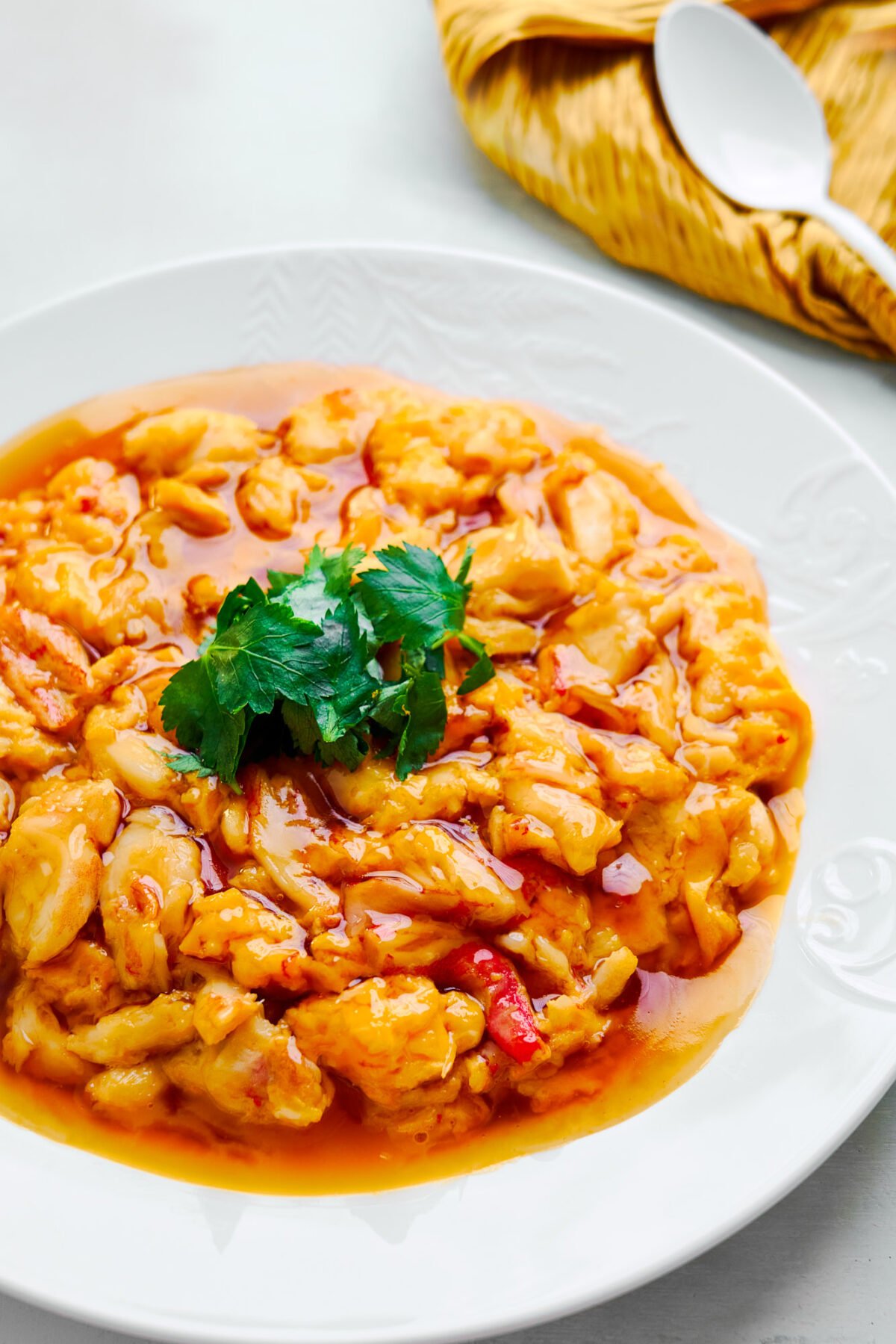I sauté some scallions for my version, which adds a mild sweetness that compliments the briny crab. The crab and egg get gently cooked together to form large tender curds before being topped off with an umami-packed sauce made with dashi. A sprinkle of mitsuba and a swipe of yuzu zest gives this a fresh brightness that balances out the rich crab and egg.
Why This Recipe Works?
Sauteeing scallion stems before adding the crab and egg adds a natural sweetness to the omelette that enhances the crab’s sweetness. Letting the egg set a little before gently stirring them allows for bigger, more fluffy curds to form. The sauce not only seasons the omelette but also has a thick viscous texture like soft scrambled eggs, which helps it blend in. Adding fresh garnishes like yuzu and mitsuba lends brightness to the rich omelette.
Ingredients for Crab Omelette
Egg - There’s nothing special here, but if you’re wondering why my yolks are so orange, it’s because the chicken they came from were fed a diet high in beta-carotene. It doesn’t affect the taste, but I think the color makes the omelette look more appetizing. Crab - I’ve used real lump crab meat for this, but if you’re trying to stay on a budget, imitation crab will work. Scallions - I like using just the white part of the scallions for the omelette as they are sweeter and more tender. I’ve used a Tokyo Negi, which is huge, but you’ll want to use a few stems if you’re using regular scallions. Dashi - This is a traditional Japanese soup stock usually made with a combination of kelp and katsuobushi (dried, smoked, and fermented skipjack tuna). I have a recipe for making dashi from scratch you can check out. You can also cheat and make it from dashi packs or powdered dashi. You can make it with other stocks, but your sauce won’t have the “Japanese” taste without it. Mirin - I’ve spent years recommending the use of sake and sugar instead of mirin because it’s been tough to find brewed mirin outside of Japan (many are just a mixture of alcohol, corn syrup, and MSG). It’s come to my attention that brewed mirin has become easier to find. If you can’t find a good one, you can use a 50:50 mixture of sugar and sake, or better yet, a 50:50 mixture of sugar and Shaoxing rice wine (I know this is Chinese, but it has a closer taste to mirin than sake). Soy sauce - I used regular Kikkoman soy sauce here. It adds umami and salt to the sauce. Potato starch - The sauce needs to be thickened so that it enrobes the egg. I like using potato starch for this because it thickens clear, and it does not get cloying or gummy, even after it’s cooled. Garnish - I like to garnish my crab omelette with some mitsuba leaves and yuzu zest. Mitsuba is in the same family as carrots and celery and has a taste that’s somewhere between the two. It can be a little hard to find unless you have a Japanese market nearby, so you can use the leftover scallion greens from the omelette or use another herb like chives or chervil. As for the yuzu, I know this can be another hard one to find, but Meyer lemon (or even regular lemon) zest makes for a great substitute.
How to Make Crab Omelette
Before you start on the omelette, you first want to mix the dashi, mirin soy sauce, and potato starch together in a small bowl, so it’s ready to go when the omelette is done. Then you’ll want to heat a small omelette pan (I used an 8-inch one) over medium heat and saute the minced scallion stems until they’re translucent and cooked through but not yet browned. Add the crab to the scallions and cook them for about a minute. The crab is already cooked, so you just need to heat it up. Pour the beaten eggs over the crab and let this cook without stirring it for about twenty seconds. This allows some of the egg to set at the bottom of the pan, giving you nice large curds. Then you can stir the eggs and crab gently to dredge up the curds and allow some of the liquid egg to flow to the bottom of the pan. You want to keep doing this until the egg is no longer runny, but stop before the egg is fully cooked, or your crab omelette won’t stick together. Now you want to let this cook until the eggs are done to your liking. I usually like them on the softer side, so I’ll pull the pan off the heat as soon as the egg forms a single mass, but you can leave it on the heat longer to cook the egg through all the way. Slide the omelette out onto a plate and then wipe out the pan and return it to the stove over high heat. Stir the sauce ingredients to make sure no starch has settled at the bottom and pour it into the pan. Keep stirring the sauce until it comes to a boil and has fully thickened. Drizzle the sauce all over the Crab Omelette and garnish with herbs and citrus zest.
Other Egg Recipes
Ramen Egg Tamagoyaki (Japanese Rolled Omelette) Japanese Egg Sandwich Chawanmushi
📖 Recipe











